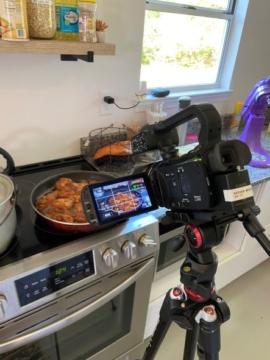Taste has long been history’s forgotten sense.
Through ongoing research conducted by 1693 Scholar Anna Arnsberger ’25 and others at James Monroe’s Highland, however, recipes are revealing enduring connections among Highland’s descendant community, legacies of enslavement in Central Virginia and the land that many families have dwelled upon for generations.
As part of a year-long project with the Institute for Integrative Conservation, Arnsberger and a research team including Josiah Tunstall ’22 and Bridget O’Keefe ’24 conducted oral histories of multiple members of the Highland Council of Descendant Advisors to document African American foodways traditions.
The research will be the basis for a community archive, owned by descendants, that documents the community’s oral histories as they relate to food, family and place.
“The community archive created from this summer’s conversations will serve as a way for several families to preserve and share their own histories,” said Highland Executive Director Sara Bon-Harper, “and the students’ learning went far beyond the topics discussed in recorded interviews.”
Descendants Angel Saylor and Jennifer Stacy are among those leading the way forward.
“To now have a relationship with William & Mary with shared authority and an active, inclusive vision for the future of Highland, it means everything,” Stacy said. “Our ancestors who started there had no voice at all, and now we’re giving them a voice. The work of the council is generating all-inclusive American history that includes the voices of our ancestors who have been largely overlooked until now.

“They get a voice now. They are heard.”
For Saylor, uncovering family history and celebrating the strength and resilience of her ancestors has been a lifelong journey.
“If someone came to me when I was younger, in elementary or middle school, and wanted to talk to me about slavery, I didn’t like it; we didn’t talk about it back then,” she said. “Now it’s a wonderful feeling, it’s an unbelievable feeling, that we are a part of something bigger, and Highland’s whole history is being told. We were there from the beginning.”
The most significant moment of the summer for Arnsberger came when she, Tunstall, O’Keefe,and Bon-Harper sat down with Saylor and Stacy to share a meal comprised of distinctive family dishes each had prepared.
“While eating a meal of fried chicken, Irish soda bread, Korean cucumbers, potato salad, sweet sauerkraut, pound cake, pecan pie bars and more, we had a great conversation about food, community and how grateful we were to have been brought together,” Arnsberger said. “The meal itself was not recorded for any research purposes, but it was representative of the connections we built through the project and through food.”
For Saylor, the shared meal “was a special moment; they wanted to know about traditions; they wanted to learn — really learn — about us and our family, and that’s special.”
The experience meant a great deal to Stacy too.
“Having that small, intimate moment with students to share recipes, to break bread together, to learn about one another,” said Stacy, “it was a window into the potential for what we can do in collaboration with the broader community, including students at William & Mary.”

Arnsberger’s longstanding interest in food and its power to represent memory, history and culture was further sparked by a course she took on the history of American food, taught by history doctoral candidate Marie Pellissier in fall 2021. Summer research then allowed Arnsberger to take important lessons gleaned from the classroom to the next level.
“It was really valuable to do work with real people instead of learning exclusively through readings or lectures,” she said. “Adding that human component made the issues so much more real and helped me realize how sometimes abstract ideas that we talk about academically have actual impacts on people.”
Arnsberger received a 1693 Scholars summer research stipend and funding from the Mellon Foundation Sharing Authority grant to support her summer work at Highland. Like many of the more than 300 undergraduate students who received summer research funding through the Charles Center for Academic Excellence this year, Arnsberger had far more interest in research than prior experience.
“I had never done any sort of research before,” she said, “so having a role in every step of the process — from writing a proposal to organizing the oral histories — helped me gain a much better understanding of what that kind of work actually looks like.”
Arnsberger’s experience at Highland not only deepened her respect for foodways and family traditions but helped to hone a range of skills, from scheduling and project management to those “relating to establishing trust and being a respectful, ethical researcher,” she said.
In addition to the academic mentorship, Arnsberger received over the course of her summer research, perhaps the most valuable lessons were offered by those she interviewed.
In reflecting on the importance of the Highland project and the ongoing role of W&M students, Saylor said, “I tell my children all the time, get all the education you can, do everything necessary to get educated, then use what you know to pave the way for others to come after you, so they can do the same.”
Applications for Charles Center Summer Research Grants for 2023 will open in late October and will be due in February.

